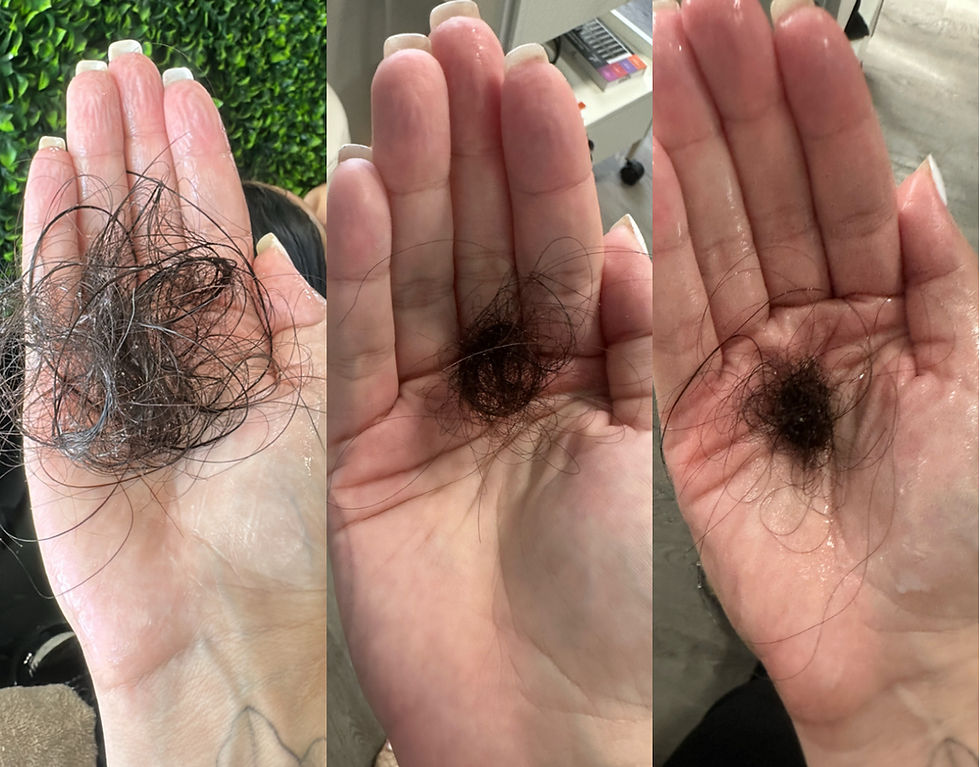Hair Hydrophobia: Why Your Hair Repels Water and How to Fix It
- Taluani Rivafelis
- Nov 6
- 4 min read

Have you ever noticed that your hair looks dry, dull, and rough — even after a deep conditioning treatment? You might be dealing with hair hydrophobia, a condition where your strands become resistant to water and hydration.
Although the name sounds scientific, treating it is much simpler than you think. Sometimes, just switching your shampoo can start bringing your hair back to life. Let’s go step-by-step through what hair hydrophobia is, what causes it, how to recognize it, and how to treat it effectively using TrichoCare’s dermocosmetic line — developed by a certified trichologist to restore true hair health.
What Is Hair Hydrophobia?
Hair hydrophobia (or hydrophobic hair) occurs when your strands repel water instead of absorbing it. The hair cuticles — the protective outer layer — become so damaged or coated that they can no longer let moisture or nutrients in.
The result? Hair that’s dry, frizzy, brittle, and lifeless, no matter how many masks or oils you use.
This condition can affect any hair type, but it’s most common in those who frequently use chemical treatments such as bleaching, straightening, or colouring.
What Causes Hair Hydrophobia?
When the cuticle layer is damaged or sealed by heavy residues, it loses its ability to retain moisture. The most common culprits include:

Chemical treatments (bleach, dyes, straighteners) that disrupt the hair’s natural barrier.
Excessive heat styling without protection, which dehydrates and burns the cuticle.
UV rays and pollution, which break down the hair’s proteins.
Aggressive shampoos containing sulfates, parabens, or alcohol that strip natural oils.
Product buildup, especially from silicones and mineral oils that create a waterproof coating.
Lack of a consistent care routine, leaving hair exposed and unprotected.
Over time, these factors lead to a “sealed” cuticle surface — preventing hydration, nutrients, and treatments from penetrating the cortex of the hair shaft.
How to Know If You Have Hair Hydrophobia ?
Your hair may be hydrophobic if you notice these signs:
Water “slides off” instead of soaking in when washing.
The hair dries too quickly yet feels rough and coarse.
Masks, oils, and conditioners seem ineffective.
Persistent dryness, frizz, or stiffness even after hydration.
Tangled, hard-to-detangle strands.
Lack of shine or elasticity.
Essentially, your hair feels like it’s wearing an invisible waterproof coat — no matter what you apply, it doesn’t penetrate.

How to Treat Hair Hydrophobia?
The goal is to restore permeability and balance. That means detoxifying buildup, rehydrating the cortex, and rebuilding the cuticle layer.
Here’s how:
1. Start with Detox and pH Rebalancing
Use a purifying scalp and hair shampoo to remove residues, metals, and product buildup that block hydration.
Try: TrichoCare Purifying Scalp Control Shampoo — formulated with Zinc Pyrithione and Piroctone Olamine to cleanse deeply while balancing the scalp’s microbiome and restoring ideal pH (around 4.5).
2. Hydrate from Within
Once your hair is “clean,” it can finally absorb moisture again. Choose humectant-rich masks containing glycerin, panthenol, hyaluronic acid, and aloe vera to reintroduce hydration.
Try: TrichoCare Hydration Therapy Mask — infused with amino acids, niacinamide, and botanical extracts that rebuild the hair’s internal moisture reserve.
3. Nourish and Protect
Seal hydration with lightweight oils and emollients that restore flexibility.
Try: TrichoCare Multifunctional Oil Blend, a luxurious dermocosmetic oil with jojoba, argan, and sacha inchi oils, designed to nourish the hair fiber without greasiness.
4. Rebuild the Structure
Alternate hydrating and strengthening masks weekly. Proteins and peptides help the hair regain elasticity and resilience.
Try: TrichoCare Scalp & Hair Repair Tonic — powered by biotin, peptides, and caffeine for follicle stimulation and structural repair.
Suggested 4-Week Repair Routine
Washing your hair at least 3 times per week and add hair masks that will promote Hydration, Nutrition and Reconstruction into your fiber:
Week 1: Hydration – Nutrition – Hydration
Week 2: Hydration – Reconstruction – Nutrition Week 3: Hydration – Nutrition – Hydration
Week 4: Hydration – Reconstruction – Nutrition
This balanced routine helps gradually re-open the cuticles, restore moisture retention, and reintroduce natural shine and softness.
Daily Tips to Prevent Hair Hydrophobia
Avoid shampoos with sulfates, silicones, and parabens.
Rinse with lukewarm or cool water — never hot.
Use a scalp detox once a week.
Limit heat styling and always use a thermal protectant.
Don’t sleep with wet or tied hair.
Drink plenty of water — hydration starts inside.
Protect hair from sun exposure with hats or UV sprays.
Consistency is key: with the right care, hydrophobic hair can regain its natural ability to absorb water and nutrients within a few weeks.
Why Choose TrichoCare
TrichoCare products are dermocosmetic-grade formulations, designed by a certified trichologist to bridge the gap between clinical treatment and home care.
Each formula combines nature, science, technology, and empathy — delivering multifunctional results with fewer products and more results.
By switching to a healthy, scalp-focused routine with TrichoCare, you’ll not only say goodbye to hair hydrophobia — you’ll restore your hair’s natural vitality, shine, and strength from the inside out.
Because healthy hair doesn’t just look beautiful — it absorbs life again. 💚







Comments